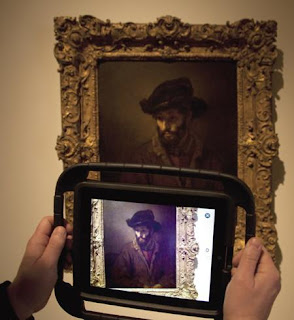Gallery One at the Cleveland Museum of Art is the new gallery space devoted to using touch-screens as a way to enhance information about various art works in the collection and as a way to interact more directly with a particular piece. Touch the screen in one spot and it may give historical context to the actual painting that hangs three or four feet behind the flat-screen on the wall. Touch the screen in another spot and it might give you information on how the painting's particular process is carried out. On another screen you can drag your finger and it gives you a splatter/drip effect with which you can fill up the screen with colors and it informs you that you're painting like Jackson Pollack used to do.(Of course Pollack had his canvas on the ground and would physically encircle it, but nevermind) Kids love it!
On another screen, this one equipped with a camera, you see your self and when you strike a pose, the screen searches a particular sculpture in the museum's database that some how matches up to the position your body pose is in. It then takes the picture with the art work next to you posing and you can email it to a friend. People get a kick out of seeing their pose linked with a Greek statue or a Religious figure. They laugh and have fun with it and a trip to the museum should be fun and loose and a sense of play should be encouraged to an extent.
The problem, and it is a major problem from my point of view, is that the museum is elevating the technology over the experience of looking at the actual physical artwork itself. In Gallery One, in one area there is a flat touch screen and three or four feet behind it is a Picasso from his Cubist period. All day long kids and students, young and old, go up to the screen and touch it and learn about the historical context of Cubism. They can drag with their finger the different parts of the painting on the screen and re-arrange them in collage fashion and be silly with the arrangement. They can do all kinds of things with the touch-screen. But all day long what barely nobody did, was to go up to the actual painting and just look and take it in. Cleveland, we have a problem.
Another aspect of CMA's emphasis on technology for the experience of the casual visitor is in the ability to sign out i-pad's equipped with a special art app so that when you wander around the museum and stop at certain pieces in the collection with an 'Art Lens' distinction on the placard, you raise up the i-pad and look at the piece thru the i-pad screen (thereby forfeiting an experience with the painting in its real size and presence) and you learn all sorts of historical context or scientific analysis on the layers underneath the painting or even little video tutorials on process. I can't help but to think we are infatuated with more and more information while at the expense of less and less meaning. It's a big mess when it comes to approaching a painting and absorbing its presence.
This culture has made mere 'image' everything. I'm all for using new technologies to enhance the learning about and better appreciating of artworks and I'm all for finding ways to get young children interested in the art museum but I'm not for any of it (and neither should the director) when these technologies are to the detriment of experiencing the actual art work. Everybody needs to take a deep breath and figure a way to help people realize that a picture of a Van Gogh on a digital screen or in a book or on a website is not the same and not as real as the actual painting. At this rate, in fifty years there will just be ultra hi-def digital reproductions of paintings hanging up in museums while the real ones collect dust behind the scenes and no one will seem to mind very much at all.

No comments:
Post a Comment